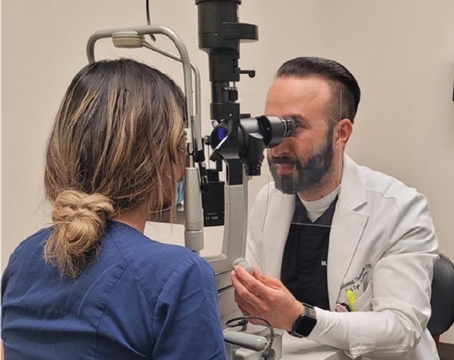According to the American Academy of Physician Assistants, there are only approximately 70 PAs currently working in ophthalmology practices. One reason for this low number is that PA students receive very little, if any, training in eye care. Two of these 70 PAs are employed by Minnesota Eye Consultants, and their main roles are performing preoperative histories and physicals for patients who are scheduled to undergo surgery and providing urgent-care services to employees. In the past year, they have also started to perform some autoimmune screening.
“Before any type of significant surgery, a patient is required to have a preoperative history and a physical to assess the risk of the anesthesia and to determine whether or not they are healthy enough to proceed with the surgery. Only physicians, physician assistants and nurse practitioners can perform these physicals,” says Laura C. Gundale, PA-C, one of the PAs at Minnesota Eye Consultants.
It is ideal for patients to be able to have their physicals performed at the ophthalmologists’ office rather than trying to schedule an appointment with their primary-care providers. “It simplifies things for our patients,” says Ms. Gundale. “If they go to their primary-care doctor to have their physicals, sometimes they can’t get in during the appropriate time period. Another problem that can arise is if a patient forgets to bring along our paperwork, the primary-care physician doesn’t know our practice’s guidelines, but if patients get their physicals done here, then it’s all pretty streamlined.”
Another benefit is ease of scheduling. According to Ms. Gundale, the physical must be done within 30 days of surgery. “Often, if a patient is having cataract surgery, we’ll do one eye and then the other eye two weeks later, so it does require some negotiating with the schedule,” she says. “Typically, I will do the physical a few days before the first procedure. For simple laser procedures, we do some of the physicals the same day as the procedure. For more complicated patients who have more complicated surgeries, I like to request records from their primary-care physician or their cardiologist. Part of the reason that we like to do it ahead of time is to make sure we have all of the information we need. If I am concerned that a patient is not optimized for surgery, I will refer him to his primary-care physician or cardiologist to get that clearance, but the majority of the time, that isn’t necessary.”
A few practices are using PAs for eye care, and Ms. Gundale notes that there are some areas into which PAs could easily expand their scope of practice. “A lot of our patients are seen for dry eye, which can be caused by allergies,” she says. “We often send patients to their primary-care doctor or to an allergist to get testing done. We would like to find a way for the PAs here to perform that testing to keep everything in-house and a little bit more streamlined for the patient. PAs are also testing for Sjögren’s syndrome, and we do a blood panel for patients who have significant dry eye and other systemic symptoms.”
In these cases, the ODs and MDs in the practice refer patients to one of the PAs, who does a brief history and physical and runs the blood panel. “If anything comes back positive, we send a letter back to the referring provider and typically refer the patient to rheumatology,” says Ms. Gundale. “Those are a few areas where we are extending our services. We have a large practice that includes ODs and MDs, so for routine eye care, I think the ODs are the more appropriate providers.”
Worth the Training and Money?
John Sheppard, MD, in practice at Virginia Eye Consultants, believes that ODs are the preferred physician extenders for ophthalmology practices. He has employed PAs in the past, but says that it wasn’t an optimized experience. “In some of the other medical fields, the skills that the PA can extend are not as highly specialized as the skills we need in ophthalmology,” says Dr. Sheppard. “The ideal clinical physician extender in ophthalmology is either a really good tech or an optometrist. The whole philosophy of physician extenders in ophthalmology is to allow the doctor to do what the doctor does best. That, of course, is the diagnosis of the condition and the recommendation for treatment and surgery. An optometrist can help with that, except in terms of the procedural surgical decision. In a routine case, the surgical decision is pretty straightforward, too, like a symptomatic cataract, and extenders can make that call reliably. That frees up the ophthalmologist to perform more surgery.”
He adds that a few select practices allow PAs to assist with the actual surgery. “The PAs in some of those practices will actually make the incision, and that includes the corneal incision and the capsulorhexis,” he says. “That’s pretty outrageous, but that’s what happens every day in cardiac surgery. The PAs are so highly trained that they will crack the chest, position the chest expander and harvest the vein. Then, the cardiovascular surgeon actually performs the coronary anastomosis.”
Dr. Sheppard notes that the PA in his office just didn’t have enough to do. Additionally, she was not trained in ophthalmology, and training her just didn’t make sense. “She was sitting around all of the time, and there wasn’t that much for her to do,” he says. “Then, we tried to use the PA to help run clinical research for us. The problem with that was that the PA needed to have not only documentation skills, but also skills in ophthalmic examination, like running all of the diagnostic devices. A PA isn’t trained in that. We would have had to train our PA just like we do our technicians. PAs have a highly competitive graduate degree, and they were taking the same orientation course to push the buttons for the visual field and OCT machines as these technicians who are fresh out of college and have far fewer qualifications than PAs do. Why would I pay a PA three times more than my technician staff to push the button on the field machine and the OCT?”
|
However, he says that if there was an eye-specific PA program curriculum like those seen in orthopedics, cardiovascular surgery or OB/GYN, where PAs have additional training with hands-on diagnostics, therapeutics and eye care, then that would all change. “But, that has to be done now in-house, and it’s just not worth it to us at that salary level,” he says.
David Hardten, MD, in practice with Ms. Gundale at Minnesota Eye Consultants, agrees. “In our practice, optometrists do most of the eye-care-related work that I have heard that some practices might hire a PA to do,” says Dr. Hardten. Our PAs are mostly responsible for preoperative physical exams for patients who are undergoing a procedure in the surgical center. They also do some care for our employees, because then they can be seen in our offices, and they don’t have to go out and take as much time off from work, and it facilitates efficient scheduling. This makes our practice more efficient, but PAs are primarily for doing preop physicals for those having cataract surgery.”
While he believes that PAs could be trained to do slit lamps and glaucoma checks and to treat conjunctivitis, corneal ulcers and other types of eye problems, optometrists in his practice are already trained to do this. “We have an optometric fellowship program where they spend a year learning advanced glaucoma and refractive and corneal management skills,” he says. “The optometrists are well-trained in managing very complicated cases of glaucoma, Fuchs’ dystrophy, keratoconus, as well as the typical patients with uveitis, conjunctivitis, and pre- and postoperative care. The supply of optometrists seems to be adequate, so I don’t see a tremendous demand for PAs to do eye care in our area.”
In contrast, he says that PAs would be more helpful to family practitioners or internal medicine doctors, because there is a shortage of them coming into practice in his area of the country. “To be useful in an eye care practice, PAs need to be able to do analysis of the optic nerve, evaluate retinal detachments, check IOP, look for corneal ulcers, remove corneal sutures, etc.,” says Dr. Hardten. “They could be trained to do that, but it seems unlikely that this would be incorporated into most PA school training, but I’m sure a special year-long training program could be created for this should there ever be a heavy demand for these skills. This could be a relatively lengthy training program, however, so they may not want to go through another year of schooling when they could go ahead and go into the workforce in the typical fields that a PA might work. In our practice, we don’t currently perceive the need for advanced eye-care management by PAs.”
Practicing Ophthalmology
Some believe that PAs could play a different role than optometrists and techs. In 2011, Rachel Reinhardt, MD, wrote a white paper about the future of physician assistants in ophthalmology that was presented at the AAO’s annual meeting.1 She conducted a review of all 50 states’ statutes and regulations and found that 22 states “have some degree of potential restriction of PA practice that could limit their scope in ophthalmology.” Twelve of those 22 states have only a small limitation of scope that generally restricts them from performing refractions or prescribing glasses or contact lenses.
However, the paper supports PAs practicing in ophthalmology practices and says they have a role that is different from that of optometrists: “If PAs enter the field of ophthalmology, it will not be to replace or duplicate the ophthalmologist, optometrist or technician, but rather to carve out a unique role in a future where ophthalmologists will be in demand.”
She adds that, “In this age of attempted expansion of optometry scope of care, including attempts and some successes, to expand optometric care to include surgery, PAs offer hope to patients and ophthalmologists. Unlike technicians and optometrists, PAs are licensed to practice medicine with physician supervision. Unlike technicians, PAs can bill for any service the physician can do. Unlike optometrists, PAs have a purely medical and surgical education. The physician-physician assistant relationship is the foundation on which the PA field has been built, and PAs are dedicated to the concept of physician-led care.”
She also notes that, “PAs can handle the routine cases in order to free up the ophthalmologist to care for the more complex medical and surgical patients for which their extensive training provides. The physician-physician assistant team would be a benefit to the future of ophthalmology.” REVIEW
1. Reinhardt RCJ. A white paper on the future of physician assistants in ophthalmology. Presented at the 2011 annual meeting of the AAO in Orlando. http://www.aao.org/member/related/upload/LDPXIII-2011-Abstracts.pdf.








